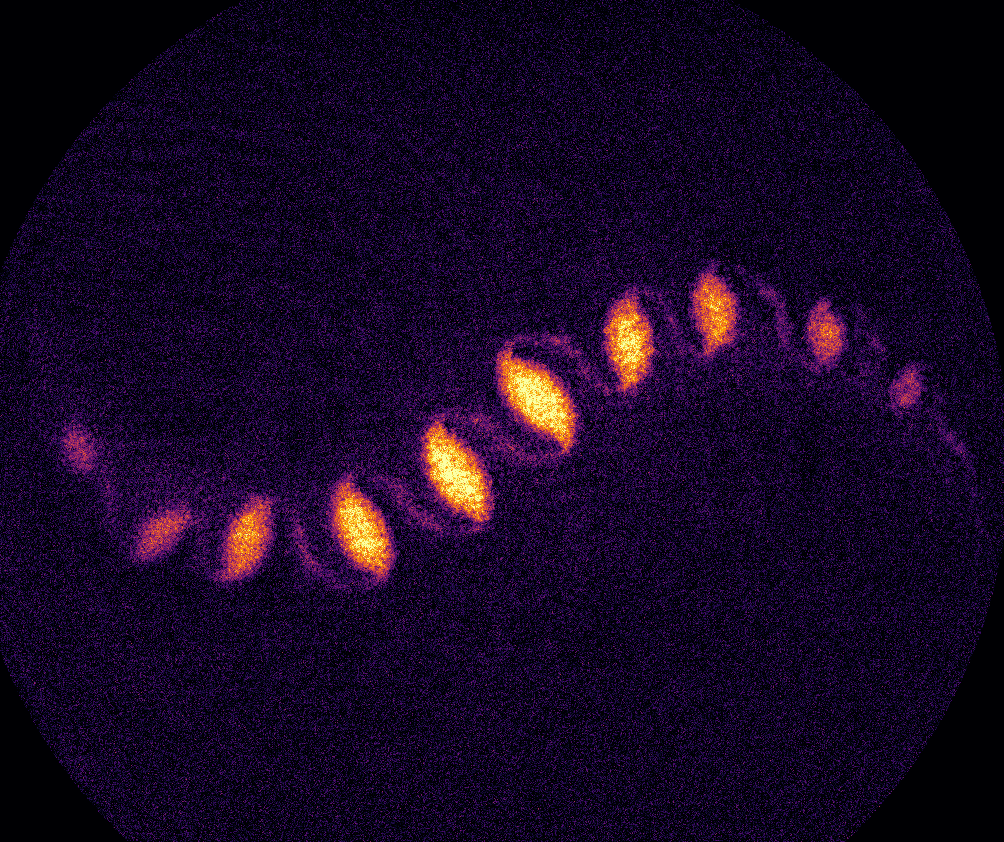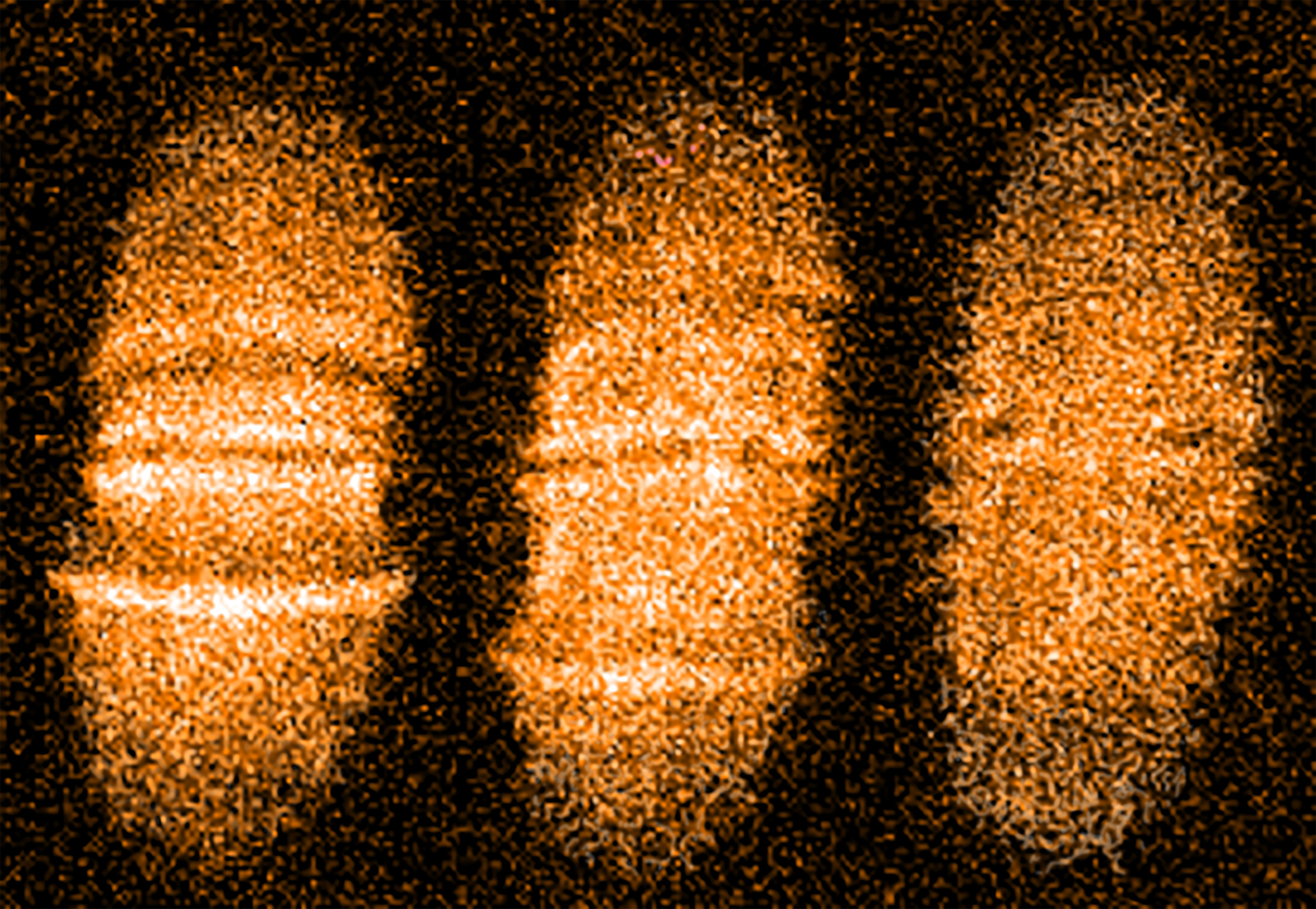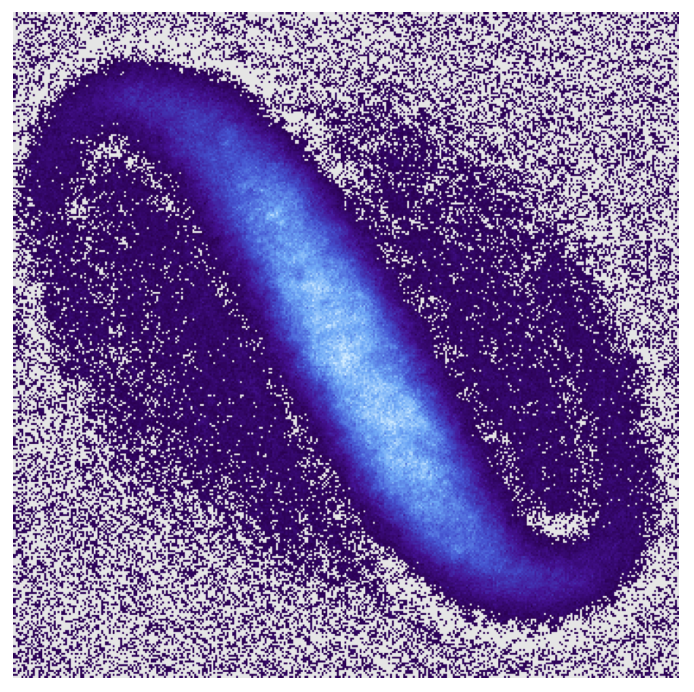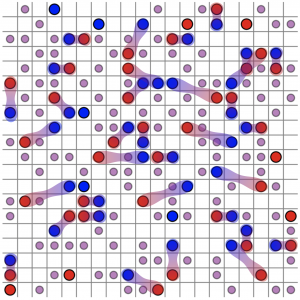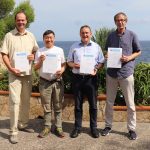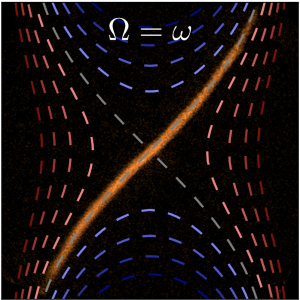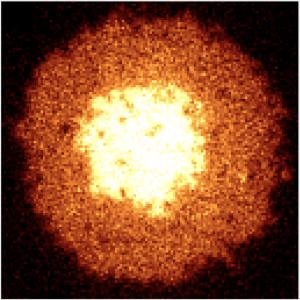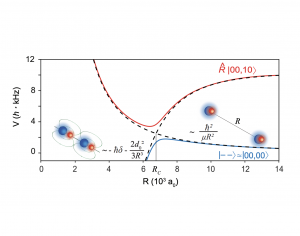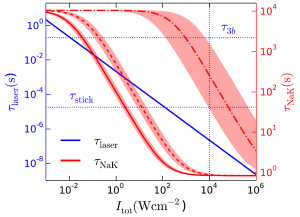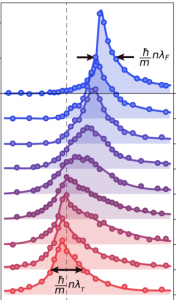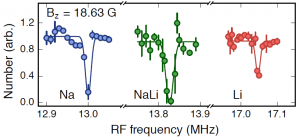Our group studies ultracold gases near absolute zero temperature. At temperatures a million times colder than interstellar space, and at densities a million times thinner than air, quantum mechanics takes center stage: Atoms behave as waves, they interfere like laser light, and form novel states of matter, such as Bose-Einstein condensates and fermionic superfluids. In ultracold Fermi gases, atoms team up in pairs that can flow without friction. This is directly related to superconductivity in metals, where electron pairs transport current without resistance. In contrast to bulk materials, we can freely tune the interaction between atoms and, for example, explore the crossover from a Bose-Einstein condensate of tightly bound molecules to a Bardeen-Cooper-Schrieffer superfluid of long-range fermion pairs. Our goal is to use these gases as model systems for strongly interacting quantum matter, from High-Tc superconductors to Neutron Stars.
Lab News
- Thermography of the superfluid transition in a strongly interacting Fermi gas (2/14/2024)
Our paper on spatially-resolved thermometry of an ultracold Fermi gas with sub-nanokelvin resolution has been published in Science.
A heat wave – second sound – sloshing back and forth in a superfluid Fermi gas.
…
Thermography of the superfluid transition in a strongly interacting Fermi gasRead More »
- Geometric squeezing of rotating quantum gases into the lowest Landau level (9/5/2023)
Valentin Crépel, Ruixiao Yao, Biswaroop Mukherjee, Richard J. Fletcher, Martin Zwierlein
The simulation of quantum Hall physics with rotating quantum gases is witnessing a revival due to recent experimental advances that enabled the observation of a Bose-Einstein condensate entirely contained in its lowest kinetic energy state, i.e. the lowest Landau level. We theoretically describe this experimental result, and show that it can be interpreted as a squeezing of the geometric degree of freedom of the problem, the guiding center metric. This “geometric squeezing” offers an unprecedented experimental control over the quantum geometry in Landau-level analogues, and at the same time opens a realistic path towards achieving correlated quantum phases akin to quantum Hall states with neutral atoms.
- Observation of chiral edge transport in a rapidly-rotating quantum gas (4/20/2023)
Observation of chiral edge transport in a rapidly-rotating quantum gas
Ruixiao Yao, Sungjae Chi, Biswaroop Mukherjee, Airlia Shaffer, Martin Zwierlein, Richard J. Fletcher
The frictionless, directional propagation of particles at the boundary of topological materials is one of the most striking phenomena in transport. These chiral edge modes lie at the heart of the integer and fractional quantum Hall effects, and their extraordinary robustness against noise and disorder reflects the quantization of Hall conductivity in these systems. Despite their central importance, controllable injection of edge modes, and direct imaging of their propagation, structure, and dynamics, is challenging. Here, we demonstrate the distillation of individual chiral edge states in a rapidly-rotating bosonic superfluid confined by an optical boundary. Tuning the wall sharpness, we reveal the smooth crossover between soft wall behaviour in which the propagation speed is proportional to wall steepness, and the hard wall regime exhibiting chiral free particles. From the skipping motion of atoms along the boundary, we spectroscopically infer the energy gap between the ground and first excited edge bands, and reveal its evolution from the bulk Landau level splitting for a soft boundary, to the hard wall limit.
- Dissipationless flow in a Bose-Fermi mixture (4/16/2023)
Zoe Z. Yan, Yiqi Ni, Alexander Chuang, Pavel E. Dolgirev, Kushal Seetharam, Eugene Demler, Carsten Robens, Martin Zwierlein
Interacting mixtures of bosons and fermions are ubiquitous in nature. They form the backbone of the standard model of physics, provide a framework for understanding quantum materials such as unconventional superconductors and two-dimensional electronic systems, and are of technological importance in 3He/4He dilution refrigerators. Bose-Fermi mixtures are predicted to exhibit an intricate phase diagram featuring coexisting liquids, supersolids, composite fermions, coupled superfluids, and quantum phase transitions in between. However, their coupled thermodynamics and collective behavior challenge our understanding, in particular for strong boson-fermion interactions. Clean realizations of fully controllable systems are scarce. Ultracold atomic gases offer an ideal platform to experimentally investigate Bose-Fermi mixtures, as the species concentration and interaction strengths can be freely tuned. Here, we study the collective oscillations of a spin-polarized Fermi gas immersed in a Bose-Einstein condensate (BEC) as a function of the boson-fermion interaction strength and temperature. Remarkably, for strong interspecies interactions the fermionic collective excitations evolve to perfectly mimic the bosonic superfluid collective modes, and fermion flow becomes dissipationless. With increasing number of thermal excitations in the Bose gas, the fermions’ dynamics exhibit a crossover from the collisionless to the hydrodynamic regime, reminiscent of the emergence of hydrodynamics in two-dimensional electron fluids. Our findings open the door towards understanding non-equilibrium dynamics of strongly interacting Bose-Fermi mixtures.
- Direct observation of non-local fermion pairing in an attractive Fermi-Hubbard gas (10/11/2022)
Thomas Hartke, Botond Oreg, Carter Turnbaugh, Ningyuan Jia, Martin Zwierlein
Pairing of fermions lies at the heart of superconductivity, the hierarchy of nuclear binding energies and superfluidity of neutron stars. The Hubbard model of attractively interacting fermions provides a paradigmatic setting for fermion pairing, featuring a crossover between Bose-Einstein condensation (BEC) of tightly bound pairs and Bardeen-Cooper-Schrieffer (BCS) superfluidity of long-range Cooper pairs, and a “pseudo-gap” region where pairs form already above the superfluid critical temperature. We here directly observe the non-local nature of fermion pairing in a Hubbard lattice gas, employing spin- and density-resolved imaging of ∼1000 fermionic 40K atoms under a bilayer microscope. Complete fermion pairing is revealed by the vanishing of global spin fluctuations with increasing attraction. In the strongly correlated regime, the fermion pair size is found to be on the order of the average interparticle spacing. We resolve polaronic correlations around individual spins, resulting from the interplay of non-local pair fluctuations and charge-density-wave order. Our techniques open the door toward in-situ observation of fermionic superfluids in a Hubbard lattice gas.
- Quantum Register of Fermion Pairs (1/26/2022)
Thomas Hartke, Botond Oreg, Ningyuan Jia, Martin W. Zwierlein
Nature 601, 537–541 (2022). download
featured in MIT News
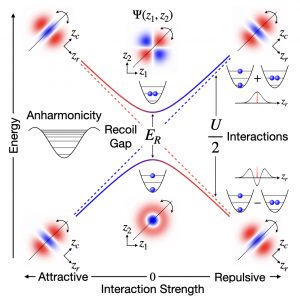
Fermions are the building blocks of matter, forming atoms and nuclei, complex materials and neutron stars. Our understanding of many-fermion systems is however limited, as classical computers are often insufficient to handle the intricate interplay of the Pauli principle with strong interactions. Quantum simulators based on ultracold fermionic atoms instead directly realize paradigmatic Fermi systems, albeit in “analog” fashion, without coherent control of individual fermions. Digital qubit-based quantum computation of fermion models, on the other hand, faces significant challenges in implementing fermionic anti-symmetrization, calling for an architecture that natively employs fermions as the fundamental unit. Here we demonstrate a robust quantum register composed of hundreds of fermionic atom pairs trapped in an optical lattice. With each fermion pair forming a spin-singlet, the qubit is realized as a set of near-degenerate, symmetry-protected two-particle wavefunctions describing common and relative motion. Degeneracy is lifted by the atomic recoil energy, only dependent on mass and lattice wavelength, thereby rendering two-fermion motional qubits insensitive against noise of the confining potential. We observe quantum coherence beyond ten seconds. Universal control is provided by modulating interactions between the atoms. Via state-dependent, coherent conversion of free atom pairs into tightly bound molecules, we tune the speed of motional entanglement over three orders of magnitude, yielding 10^4 Ramsey oscillations within the coherence time. For site-resolved motional state readout, fermion pairs are coherently split into a double well, creating entangled Bell pairs. The methods presented here open the door towards fully programmable quantum simulation and digital quantum computation based on fermions.
- Crystallization of Bosonic Quantum Hall States (1/5/2022)
Biswaroop Mukherjee, Airlia Shaffer, Parth B. Patel, Zhenjie Yan, Cedric C. Wilson, Valentin Crépel, Richard J. Fletcher, Martin W. Zwierlein
Nature 601, 58-62 (2022) download
Featured in MIT News, Smithsonian Magazine, Popular Science, and on the Apple News feed
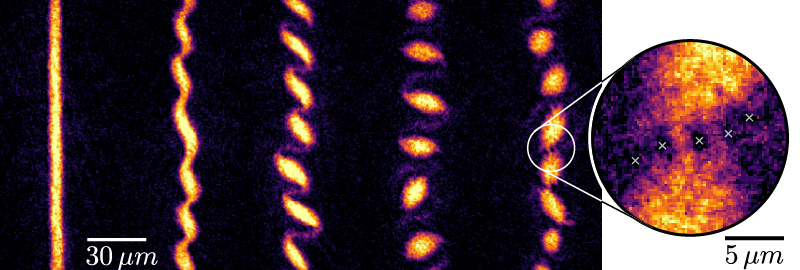
The dominance of interactions over kinetic energy lies at the heart of strongly correlated quantum matter, from fractional quantum Hall liquids, to atoms in optical lattices and twisted bilayer graphene. Crystalline phases often compete with correlated quantum liquids, and transitions between them occur when the energy cost of forming a density wave approaches zero. A prime example occurs for electrons in high magnetic fields, where the instability of quantum Hall liquids towards a Wigner crystal is heralded by a roton-like softening of density modulations at the magnetic length. Remarkably, interacting bosons in a gauge field are also expected to form analogous liquid and crystalline states. However, combining interactions with strong synthetic magnetic fields has been a challenge for experiments on bosonic quantum gases. Here, we study the purely interaction-driven dynamics of a Landau gauge Bose-Einstein condensate in and near the lowest Landau level (LLL). We observe a spontaneous crystallization driven by condensation of magneto-rotons, excitations visible as density modulations at the magnetic length. Increasing the cloud density smoothly connects this behaviour to a quantum version of the Kelvin-Helmholtz hydrodynamic instability, driven by the sheared internal flow profile of the rapidly rotating condensate. At long times the condensate self-organizes into a persistent array of droplets, separated by vortex streets, which are stabilized by a balance of interactions and effective magnetic forces.
- BEC Prize 2021 (10/25/2021)
Martin wins the Toptica BEC Junior Award 2021 “for his pioneering contributions to the field of ultracold quantum gases, specifically Fermi and Bose polarons, rotating condensates, spin and charge transport and the unitary Fermi gas.”
https://bec2021.org/bec-award/
Tilman Esslinger and Rudolf Grimm received the BEC Senior Award, and Tin-Lun (Jason) Ho the BEC Lifetime Award. The happy tetramer:
- Geometric squeezing into the lowest Landau level (6/18/2021)
Richard J. Fletcher, Airlia Shaffer, Cedric C. Wilson, Parth B. Patel, Zhenjie Yan, Valentin Crépel, Biswaroop Mukherjee, Martin W. Zwierlein
Science 18 Jun 2021:
Vol. 372, Issue 6548, pp. 1318-1322The physics of rotation plays a fundamental role across all physical arenas, from nuclear matter, to weather patterns, star formation, and black holes. The behaviour of neutral objects in a rotating frame is equivalent to that of charged particles in a magnetic field, which exhibit intriguing transport phenomena such as the integer and fractional quantum Hall effects. An intrinsic feature of both these systems is that translations along different directions do not commute, implying a Heisenberg uncertainty relation between spatial coordinates. This underlying non-commutative geometry plays a crucial role in quantum Hall systems, but its effect on the dynamics of individual wavefunctions has not been observed. Here, we exploit the ability to squeeze non-commuting variables to dynamically create a Bose-Einstein condensate in the lowest Landau level (LLL). We directly resolve the extent of the zero-point cyclotron orbits, and demonstrate geometric squeezing of the orbits’ guiding centres by more than 7 dB below the standard quantum limit. The condensate attains an aspect ratio exceeding 100 and an angular momentum of more than 1000ℏ per particle. This protocol naturally prepares a condensate in which all atoms occupy a single Landau gauge wavefunction in the LLL, with an interparticle distance approaching the size of the cyclotron orbits, offering a new route towards strongly correlated fluids and bosonic quantum Hall states.
- Universal Sound Diffusion in a Strongly Interacting Fermi Gas (12/4/2020)
Parth B. Patel, Zhenjie Yan, Biswaroop Mukherjee, Richard J. Fletcher, Julian Struck, Martin W. Zwierlein
Science 370, 1222-1226 (2020)
MIT News: Physicists capture the sound of a “perfect” fluid
BBC Radio 4:
Radio podcasts: WGBH Radio
New Scientist, Popular Mechanics
Transport of strongly interacting fermions governs modern materials — from the high-Tc cuprates to bilayer graphene –, but also nuclear fission, the merging of neutron stars and the expansion of the early universe. Here we observe a universal quantum limit of diffusivity in a homogeneous, strongly interacting Fermi gas of atoms by studying sound propagation and its attenuation via the coupled transport of momentum and heat. In the normal state, the sound diffusivity D monotonically decreases upon lowering the temperature T, in contrast to the diverging behavior of weakly interacting Fermi liquids. As the superfluid transition temperature is crossed, D attains a universal value set by the ratio of Planck’s constant h and the particle mass m. This finding of quantum limited sound diffusivity informs theories of fermion transport, with relevance for hydrodynamic flow of electrons, neutrons and quarks.
- Bose polarons near quantum criticality (4/10/2020)
Zoe Z. Yan, Yiqi Ni, Carsten Robens, Martin W. Zwierlein
Science, 368, 190-194 (2020)
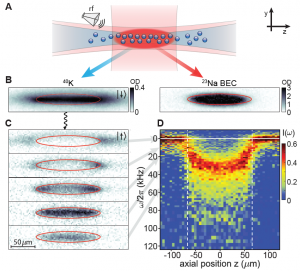
The emergence of quasiparticles in strongly interacting matter represents one of the cornerstones of modern physics. However, when different phases of matter compete near a quantum critical point, the very existence of quasiparticles comes under question. Here we create Bose polarons near quantum criticality by immersing atomic impurities in a Bose-Einstein condensate (BEC) with near-resonant interactions. Using locally-resolved radiofrequency spectroscopy, we probe the energy, spectral width, and short-range correlations of the impurities as a function of temperature. Far below the superfluid critical temperature, the impurities form well-defined quasiparticles. However, their inverse lifetime, given by their spectral width, is observed to increase linearly with temperature, a hallmark of quantum critical behavior. Close to the BEC critical temperature, the spectral width exceeds the binding energy of the impurities, signaling a breakdown of the quasiparticle picture near quantum criticality.
- Congratulations to Dr. Richard Fletcher on his Assistant Professorship at MIT (3/29/2020)
We are all excited for Rich to be starting his own research group at MIT!
- Doublon-Hole Correlations and Fluctuation Thermometry in a Fermi-Hubbard Gas (3/25/2020)
Thomas Hartke, Botond Oreg, Ningyuan Jia, Martin Zwierlein
Phys. Rev. Lett. 125, 113601 (2020)
DOI:10.1103/PhysRevLett.125.113601
We report on the single atom and single site-resolved detection of the total density in a cold atom realization of the 2D Fermi-Hubbard model. Fluorescence imaging of doublons is achieved by splitting each lattice site into a double well, thereby separating atom pairs. Full density readout yields a direct measurement of the equation of state, including direct thermometry via the fluctuation-dissipation theorem. Site-resolved density correlations reveal the Pauli hole at low filling, and strong doublon-hole correlations near half filling. These are shown to account for the difference between local and non-local density fluctuations in the Mott insulator. Our technique enables the study of atom-resolved charge transport in the Fermi-Hubbard model, the site-resolved observation of molecules, and the creation of bilayer Fermi-Hubbard systems.
- Resonant dipolar collisions of ultracold molecules induced by microwave dressing (3/5/2020)
Zoe Z. Yan, Jee Woo Park, Yiqi Ni, Huanqian Loh, Sebastian Will, Tijs Karman, Martin Zwierlein
Phys. Rev. Lett. 125, 063401 (2020)
10.1103/PhysRevLett.125.063401
We demonstrate microwave dressing on ultracold, fermionic 23Na40K ground-state molecules and observe resonant dipolar collisions with cross sections exceeding three times the s-wave unitarity limit. The origin of these collisions is the resonant alignment of the approaching molecules’ dipoles along the intermolecular axis, which leads to strong attraction. We explain our observations with a conceptually simple two-state picture based on the Condon approximation. Furthermore, we perform coupled-channels calculations that agree well with the experimentally observed collision rates. While collisions are observed here as laser-induced loss, microwave dressing on chemically stable molecules trapped in box potentials may enable the creation of strongly interacting dipolar gases of molecules.
- Photo-induced two-body loss of ultracold molecules (5/16/2019)
Arthur Christianen, Martin W. Zwierlein, Gerrit C. Groenenboom, Tijs Karman
Phys. Rev. Lett. 123, 123402 (2019)
The lifetime of nonreactive ultracold bialkali gases was conjectured to be limited by sticky collisions amplifying three-body loss. We show that the sticking times were previously overestimated and do not support this hypothesis. We find that electronic excitation of NaK+NaK collision complexes by the trapping laser leads to the experimentally observed two-body loss. We calculate the excitation rate with a quasiclassical, statistical model employing ab initio potentials and transition dipole moments. Using longer laser wavelengths or repulsive box potentials may suppress the losses.
- Congratulations to Dr. Lawrence Cheuk on his Assistant Professorship at Princeton University (4/12/2019)
We wish Lawrence success and wonderful discoveries with his new research group!
Check out his homepage: https://sites.google.com/view/cheuk-lab/home
- Spectral response and contact of the unitary Fermi gas (2/26/2019)
Biswaroop Mukherjee, Parth B. Patel, Zhenjie Yan, Richard J. Fletcher, Julian Struck, Martin W. Zwierlein
Spectral response and contact of the unitary Fermi gas
We measure radiofrequency (rf) spectra of the homogeneous unitary Fermi gas at temperatures ranging from the Boltzmann regime through quantum degeneracy and across the superfluid transition. For all temperatures, a single spectral peak is observed. Its position smoothly evolves from the bare atomic resonance in the Boltzmann regime to a frequency corresponding to nearly one Fermi energy at the lowest temperatures. At high temperatures, the peak width reflects the scattering rate of the atoms, while at low temperatures, the width is set by the size of fermion pairs. Above the superfluid transition, and approaching the quantum critical regime, the width increases linearly with temperature, indicating non-Fermi-liquid behavior. From the wings of the rf spectra, we obtain the contact, quantifying the strength of short-range pair correlations. We find that the contact rapidly increases as the gas is cooled below the superfluid transition.
- Spin Transport in a Mott Insulator of Ultracold Fermions (12/6/2018)
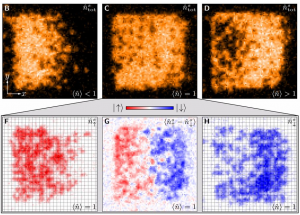 Matthew A. Nichols, Lawrence W. Cheuk, Melih Okan, Thomas R. Hartke, Enrique Mendez, T. Senthil, Ehsan Khatami, Hao Zhang, Martin W. Zwierlein
Matthew A. Nichols, Lawrence W. Cheuk, Melih Okan, Thomas R. Hartke, Enrique Mendez, T. Senthil, Ehsan Khatami, Hao Zhang, Martin W. Zwierlein
Science, 363, 383 (2019)Science Perspective by Jean-Philippe Brantut, EPFL Lausanne
MIT News Article by Helen Knight
Strongly correlated materials are expected to feature unconventional transport properties, where charge, spin, and heat conduction are potentially independent probes of the dynamics. In contrast to charge transport, the measurement of spin transport in such materials is highly challenging. Here we observe spin conduction and diffusion in a system of ultracold fermionic atoms that realizes the half-filled Fermi-Hubbard model. For strong interactions, spin diffusion is driven by super-exchange and doublon-hole-assisted tunneling, and strongly violates the quantum limit of charge diffusion. The technique developed in this work can be extended to finite doping, which can shed light on the complex interplay between spin and charge in the Hubbard model.
- Boiling a Unitary Fermi Liquid (11/1/2018)
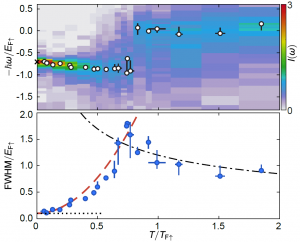 Zhenjie Yan, Parth B. Patel, Biswaroop Mukherjee, Richard J. Fletcher, Julian Struck, Martin W. Zwierlein
Zhenjie Yan, Parth B. Patel, Biswaroop Mukherjee, Richard J. Fletcher, Julian Struck, Martin W. ZwierleinPhys. Rev. Lett. 122, 093401 (2019)
See Viewpoint by Pietro Massignan: From Quantum Quasiparticles to a Classical Gas
We study the thermal evolution of a highly spin-imbalanced, homogeneous Fermi gas with unitarity limited interactions, from a Fermi liquid of polarons at low temperatures to a classical Boltzmann gas at high temperatures. Radio-frequency spectroscopy gives access to the energy, lifetime and the short-range correlations of Fermi polarons at low temperatures T. In this regime we observe a characteristic $\propto T^2$ dependence of the spectral width, corresponding to the quasiparticle decay rate expected for a Fermi liquid. At high T the spectral width decreases again towards the scattering rate of the classical, unitary Boltzmann gas, $\propto T^{1/2}$. In the transition region between the quantum degenerate and classical regime, the spectral width attains its maximum, on the scale of the Fermi energy, indicating the breakdown of a quasiparticle description. Density measurements in a harmonic trap directly reveal the majority dressing cloud surrounding the minority spins, and yield the compressibility along with the effective mass of Fermi polarons.
- Two-Photon Spectroscopy of the NaLi Triplet Ground State (12/19/2017)
Timur M. Rvachov, Hyungmok Son, Juliana J. Park, Sepehr Ebadi, Martin W. Zwierlein, Wolfgang Ketterle, Alan O. Jamison
Phys. Chem. Chem. Phys., 20, 4739-4745 (2018)
We employ two-photon spectroscopy to study the vibrational states of the triplet ground state potential (a3Σ+) of the 23Na6Li molecule. Pairs of Na and Li atoms in an ultracold mixture are photoassociated into an excited triplet molecular state, which in turn is coupled to vibrational states of the triplet ground potential. Vibrational state binding energies, line strengths, and potential fitting parameters for the triplet ground a3Σ+potential are reported. We also observe rotational splitting in the lowest vibrational state.
- Photoassociation of Ultracold NaLi (12/19/2017)
Timur M. Rvachov, Hyungmok Son, Juliana J. Park, Pascal M. Notz, Tout T. Wang, Martin W. Zwierlein, Wolfgang Ketterle, Alan O. Jamison
Phys. Chem. Chem. Phys., 2018,20, 4746-4751 (2018)
We perform photoassociation spectroscopy in an ultracold 23Na-6Li mixture to study the c3Σ+ excited triplet molecular potential. We observe 50 vibrational states and their substructure to an accuracy of 20 MHz, and provide line strength data from photoassociation loss measurements. An analysis of the vibrational line positions using near-dissociation expansions and a full potential fit is presented. This is the first observation of the c3Σ+ potential, as well as photoassociation in the NaLi system.
- Congratulations to Dr. Julian Struck for receiving the CNRS Junior Research Chair at ENS Paris (8/1/2017)
All the best of luck to Julian!
- Second-Scale Nuclear Spin Coherence Time of Ultracold NaK Molecules (7/28/2017)

Jee Woo Park, Zoe Z. Yan, Huanqian Loh, Sebastian A. Will, Martin W. Zwierlein Coherence, the stability of the relative phase between quantum states, lies at the heart of quantum mechanics. Applications such as precision measurement, interferometry, and quantum computation are enabled by physical systems that have quantum states with robust coherence. With the creation of molecular ensembles at sub-μK temperatures, diatomic molecules have become a novel system under full quantum control. Here, we report on the observation of stable coherence between a pair of nuclear spin states of ultracold fermionic NaK molecules in the singlet rovibrational ground state. Employing microwave fields, we perform Ramsey spectroscopy and observe coherence times on the scale of one second. This work opens the door for the exploration of single molecules as a versatile quantum memory. Switchable long-range interactions between dipolar molecules can further enable two-qubit gates, allowing quantum storage and processing in the same physical system. Within the observed coherence time, 104 one- and two-qubit gate operations will be feasible.
- Long-Lived Ultracold Molecules with Electric and Magnetic Dipole Moments (7/12/2017)
Timur M. Rvachov, Hyungmok Son, Ariel T. Sommer, Sepehr Ebadi, Juliana J. Park, Martin W. Zwierlein, Wolfgang Ketterle, Alan O. Jamison
Phys. Rev. Lett. 119, 143001 (2017)
We create fermionic dipolar 23Na6Li molecules in their triplet ground state from an ultracold mixture of 23Na and 6Li. Using magneto-association across a narrow Feshbach resonance followed by a two-photon STIRAP transfer to the triplet ground state, we produce 3×10^4 ground state molecules in a spin-polarized state. We observe a lifetime of 4.6s in an isolated molecular sample, approaching the p-wave universal rate limit. Electron spin resonance spectroscopy of the triplet state was used to determine the hyperfine structure of this previously unobserved molecular state.
- Homogeneous Atomic Fermi Gases (10/31/2016)

Biswaroop Mukherjee, Zhenjie Yan, Parth B. Patel, Zoran Hadzibabic, Tarik Yefsah, Julian Struck, Martin W. Zwierlein Phys. Rev. Lett. 118, 123401 (2017), arXiv:1610.10100

We report on the creation of homogeneous Fermi gases of ultracold atoms in a uniform potential. In the momentum distribution of a spin-polarized gas, we observe the emergence of the Fermi surface and the saturated occupation of one particle per momentum state. This directly confirms Pauli blocking in momentum space. For the spin-balanced unitary Fermi gas, we observe spatially uniform pair condensates. For thermodynamic measurements, we introduce a hybrid potential that is harmonic in one dimension and uniform in the other two. The spatially resolved compressibility reveals the superfluid transition in a spin-balanced Fermi gas, saturation in a fully polarized Fermi gas, and strong attraction in the polaronic regime of a partially polarized Fermi gas.
- Martin Zwierlein receives I.I. Rabi Prize of the American Physical Society (10/12/2016)
- Two and Three-body Contacts in the Unitary Bose Gas (8/15/2016)

Richard J. Fletcher, Raphael Lopes, Jay Man, Nir Navon, Robert P. Smith, Martin W. Zwierlein, Zoran Hadzibabic Science 355, 377-380 (2017), arXiv:1608.04377
In many-body systems governed by pairwise contact interactions, a wide range of observables is linked by a single parameter, the two-body contact, which quantifies two-particle correlations. This profound insight has transformed our understanding of strongly interacting Fermi gases. Here, using Ramsey interferometry, we study coherent evolution of the resonantly interacting Bose gas, and show that it cannot be explained by only pairwise correlations. Our experiments reveal the crucial role of three-body correlations arising from Efimov physics, and provide a direct measurement of the associated three-body contact.
- Congratulations to Dr. Tarik Yefsah for starting his position as CNRS Permanent Researcher (8/1/2016)
All the best to Tarik for a continued string of wonderful discoveries.
Check out his latest news: http://www.lkb.upmc.fr/ultracoldfermigases/yefsah/
- Congratulations to Dr. Sebastian Will for his Assistant Professorship at Columbia University (8/1/2016)
All the best of luck and success to Sebastian with his new research group at Columbia.
Check out their webpage: https://www.will-lab.com/ - Spatial Charge and Spin Correlations in the 2D Fermi-Hubbard Model (6/13/2016)

Lawrence W. Cheuk, Matthew A. Nichols, Katherine R. Lawrence, Melih Okan, Hao Zhang, Ehsan Khatami, Nandini Trivedi, Thereza Paiva, Marcos Rigol, Martin W. Zwierlein Science 353, 1260-1264 (2016), arXiv:1606.04089
Strong electron correlations lie at the origin of transformative phenomena such as colossal magneto-resistance and high-temperature superconductivity. Already near room temperature, doped copper oxide materials display remarkable features such as a pseudo-gap and a “strange metal” phase with unusual transport properties. The essence of this physics is believed to be captured by the Fermi-Hubbard model of repulsively interacting, itinerant fermions on a lattice. Here we report on the site-resolved observation of charge and spin correlations in the two-dimensional (2D) Fermi-Hubbard model realized with ultracold atoms. Antiferromagnetic spin correlations are maximal at half-filling and weaken monotonically upon doping. Correlations between singly charged sites are negative at large doping, revealing the Pauli and correlation hole\textemdash a suppressed probability of finding two fermions near each other. However, as the doping is reduced below a critical value, correlations between such local magnetic moments become positive, signaling strong bunching of doublons and holes. Excellent agreement with numerical linked-cluster expansion (NLCE) and determinantal quantum Monte Carlo (DQMC) calculations is found. Positive non-local moment correlations directly imply potential energy fluctuations due to doublon-hole pairs, which should play an important role for transport in the Fermi-Hubbard model.
- Observation of 2D Fermionic Mott Insulators (4/1/2016)

Lawrence W. Cheuk, Matthew A. Nichols, Katherine R. Lawrence, Melih Okan, Hao Zhang, Martin W. Zwierlein Phys. Rev. Lett. 116, 235301 (2016); arXiv:1604.00096 (2016)
We report on the site-resolved observation of characteristic states of the two-dimensional repulsive Fermi-Hubbard model, using ultracold 40K atoms in an optical lattice. By varying the tunneling, interaction strength, and external confinement, we realize metallic, Mott-insulating, and band-insulating states. We directly measure the local moment, which quantifies the degree of on-site magnetization, as a function of temperature and chemical potential. Entropies per particle as low as 0.99(6)kB indicate that nearest-neighbor antiferromagnetic correlations should be detectable using spin-sensitive imaging.
- Coherent Microwave Control of Ultracold NaK Molecules (4/1/2016)

Sebastian A. Will, Jee Woo Park, Zoe Z. Yan, Huanqian Loh, Martin W. Zwierlein Phys. Rev. Lett. 116, 225306 (2016), arXiv:1604.00120
We demonstrate coherent microwave control of rotational and hyperfine states of trapped, ultracold, and chemically stable NaK molecules. Starting with all molecules in the absolute rovibrational and hyperfine ground state, we study rotational transitions in combined magnetic and electric fields and explain the rich hyperfine structure. Following the transfer of the entire molecular ensemble into a single hyperfine level of the first rotationally excited state, J=1, we observe collisional lifetimes of more than 3s, comparable to those in the rovibrational ground state, J=0. Long-lived ensembles and full quantum state control are prerequisites for the use of ultracold molecules in quantum simulation, precision measurements and quantum information processing.
- Cascade of Solitonic Excitations in a Superfluid Fermi Gas (1/27/2016)

Mark J.-H. Ku, Biswaroop Mukherjee, Tarik Yefsah, and Martin W. Zwierlein Phys. Rev. Lett. 116, 045304 (2016), arXiv:1507.01047
We follow the time evolution of a superfluid Fermi gas of resonantly interacting 6Li atoms after a phase imprint. Via tomographic imaging, we observe the formation of a planar dark soliton, its subsequent snaking, and its decay into a vortex ring, which in turn breaks to finally leave behind a single solitonic vortex. In intermediate stages we find evidence for an exotic structure resembling the Φ-soliton, a combination of a vortex ring and a vortex line. Direct imaging of the nodal surface reveals its undulation dynamics and its decay via the puncture of the initial soliton plane. The observed evolution of the nodal surface represents dynamics beyond superfluid hydrodynamics, calling for a microscopic description of unitary fermionic superfluids out of equilibrium.
- Ultracold Dipolar Gas of Fermionic NaK Molecules (5/15/2015)

Illustration: Jose-Luis Olivares/MIT
Jee Woo Park, Sebastian A. Will, and Martin W. Zwierlein
Phys. Rev. Lett. 114, 205302 (2015)


Coverage in Scientific American, Pro-Physik.de, Huffington Post, Live Science, and others
We report on the creation of an ultracold (500 Nanokelvin) dipolar gas of fermionic NaK molecules in their absolute rovibrational and hyperfine ground state. The molecular gas is formed from a mixture of ultracold gases of sodium and potassium atoms, which are first associated into a very loosely bound (Feshbach) molecule. These highly vibrationally excited molecules are then coherently transferred into the absolute rovibrational ground state. The two-photon process bridges an energy gap worth 7500 Kelvin, without the injection of heat. The nearly quantum degenerate molecular gas displays a lifetime longer than 2.5 seconds, highlighting NaK’s stability against two-body chemical reactions. A homogeneous electric field is applied to induce a dipole moment of up to 0.8 Debye. With these advances, the exploration of many-body physics with strongly dipolar Fermi gases of NaK molecules is within experimental reach.

